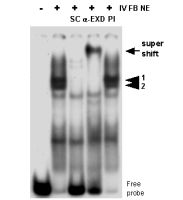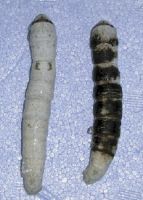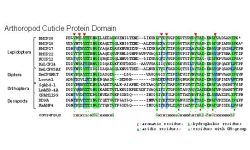|
|
 Biochemistry Laboratory
Biochemistry Laboratory
|
Our research interests are the regulation of gene expression, the mechanisms of immunity, and the cuticle construction of insects. We are analyzing them by using molecular and biochemical approaches.
|
|
Asc Prof |
Susumu Izumi |
e-mail |
|
|
Ast Prof |
Tsunaki Asano |
e-mail |
|
|
|
Study on the regulation of gene expression in insect
|
|

Gel retardation assay
Many tissues and organs have a variety of structures and functions in multicellular organisms including human beings. They originally arise from one cell during development. This is achieved by ordered and precise control of the temporal and spatial expression of genetic information that is coded in the genome of each cell. To understand the molecular mechanisms by which expression of genetic information is precisely regulated, we are studying 'insect metamorphosis' through genetic, biochemical, and molecular biological approaches. We are focusing on this phenomenon since it includes dramatic alterations in the morphology and behavior of animals in a short period of time.
|
|
|
Insect immunity
|
|

Melanization of cuticle caused by surface injury
The insect is an excellent model system for studying innate immunity, since insects have very efficient recognition and elimination systems against foreign pathogens, despite the lack of adaptive immunity. Insect immune response includes melanin synthesis by proPO cascade, anti-microbial peptidesf synthesis, signaling pathways such as Toll and Imd, and so on. Currently we are trying to identify novel factors involved in 1) melanization cascade and 2) surface epithelial immunity.
|
|
|
Study on the molecular mechanism of cuticle construction in insect
|
|

Chitin recognition domains
Insect cuticle, which is composed mainly of various proteins and chitin, serves as exoskeleton and determines the shape of bodies. It also functions as a barrier to the environment surrounding the individual insect. It is flexible, elastic and white when first formed, however in most pupae and adults it undergoes chemical processes which result in hardening and darkening and which are referred to as 'sclerotization'. We are studying the molecular mechanism of cuticle sclerotization paying attention to laccase type phenoloxidase. We are also interested in the chitin recognition mechanism and biosynthesis of cuticle proteins.
|
|
|
Recent Publications
|
|
- Ogawa, N., Kishimoto, A., Asano, T. and Izumi, S. (2004) Repressive JH response element in the 5'-flanking DNA of the Bombyx major plasma protein gene. Insect Biochem. Mol. Biol. 35, 217-229.
- Togawa, T., Nakato, H. and Izumi, S. (2004) Analysis for the chitin recognition mechanism of cuticle proteins from the soft cuticle of the silkworm, Bombyx mori. Insect Biochem. Mol. Biol. 34, 1059-1067.
- Fujise, M., Takeo, S., Kamimura, K., Matsuo, T., Aigaki, T., Izumi, S. and Nakato H. (2003) Dally regulates Dpp morphogen gradient formation in the Drosophila wing. Development. 130, 1515-22.
- Takemae, H., Ueda, R., Okubo, R., Nakato, H., Izumi, S., Saigo, K., Nishihara, S. (2003) Proteoglycan UDP-galactose:beta-xylose beta 1,4-galactosyltransferase I is essential for viability in Drosophila melanogaster. J Biol Chem. 278, 15571-8.
- Sawada, H., Nakagoshi, M., Yamamoto, T., Kato, T., Mase, K., Yamamoto, T. and Izumi, S. (2002) Purification and characterization of an ommin-binding protein from an acid-methanol extract of diapause eggs of the silkworm, Bombyx mori. J. Insect Biotech. Seric. 71, 103-108
- Obara, Y., Miyatani, M., Ishiguro, Y., Hirota, K., Koyama, T., Izumi, S. Iwami, M. and Sakurai, S. (2002) Pupal commitment and its hormonal control in wing imaginal discs. J. Insect Physiol. 48, 933-944
- Fujise, M., Izumi, S., Selleck, S. G. and Nakato, H. (2001) Regulation of dally, an integral membrane proteoglycan, and its function during adult sensory organ formation of Drosophila. Dev. Biol. 235, 433-448
- Tsuda, M., Izumi, S. and Nakato, H. (2001) Transcriptional and posttranscriptional regulation of the gene for Dally, a Drosophila integral membrane proteoglycan. FEBS Lett. 494, 241-245
- Kamimura, K., Fujise, M., Izumi, S., Habuchi, H., Kimata, K. and Nakato, H. (2001) Drosophila heparan sulfate 6-O-sulfotransferase (dHS6ST) gene. Structure, expression, and function in the formation of the tracheal system. J. Biol. Chem. 276, 17014-17021
- Togawa, T, Shofuda, K. -i., Yaginuma, T., Tomino, S. Nakato, H. and Izumi, S. (2001) Structural analysis of gene encoding cuticle protein BMCP18, and characterization of its putative transcription factor in the silkworm, Bombyx mori. Insect Biochem. Molec. Biol. 31, 611-620.
- Asano, T and Ashida, M. (2001) Cuticular pro-phenoloxidase of the silkworm, Bombyx mori. Purification and demonstration of its transport from hemolymph. J Biol Chem., 27, 11100-11112.
- Asano, T and Ashida, M. (2001) Transepithelially transported pro-phenoloxidase in the cuticle of the silkworm, Bombyx mori. Identification of its methionyl residues oxidized to methionine sulfoxides. J Biol Chem., 276,11113-11125.
|
|
|